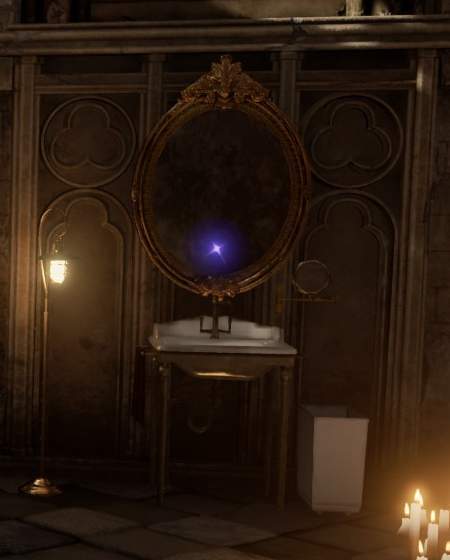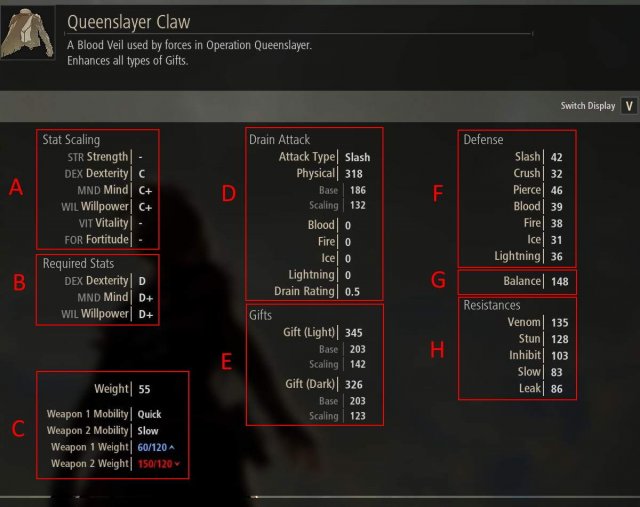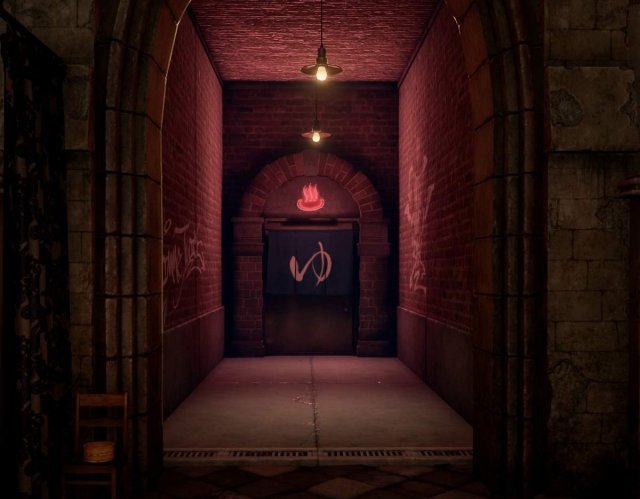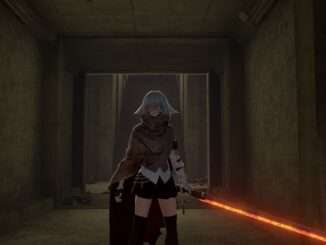
A guide to explain the mechanics of the game to newcomers, written without spoiler so as to be usable from the start of the game (past the tutorial). If you are new to the game and a bit lost as to how things work, this guide should hopefully help you out.
Contents
I. About
All credit goes to Yomi . April Skye!
Hopefully, this guide will teach you the basics of the game and the underlying mechanics specific to Code VEIN. This is entirely meant for beginners, and I doubt any veteran will learn anything but you never know. What this guide will not do is give you outright setups that are to be copied 1:1.
In short, this guide will teach you about building, not builds.
The goal of this guide is to help people figure out how the game works so they can decide for themselves what they feel most comfortable playing, without spoiling elements of the story.
This guide assumes that you have finished the tutorial, and met with your first companion.
If not, I advise you do so before reading onward.
I know the In-Game Hints are similar to what is said here, but I don’t find them easy to access and looking only one at a time is a pain. Hopefully this guide will help at least some people.
II. Lexicon
Since Code Vein uses a lot of specific terminology, if you ever get lost in it here is a quick breakdown:
- Block – Regular block activated by holding down the block button and facing the enemy.
- Blood Veils – Armor.
- Drain Attack – Any attack that will replenish your ichor, uses a different stat than the regular attacks. More on that below.
- Gifts – Skills (both passive and active).
- Haze – Money/Experience/Souls.
- Ichor – Mana/MP/SP, is used to cast active Gifts.
- Lost – Enemies.
- Mistle – Checkpoints/Bonfire.
- Parry – Timed block that will result in a special drain attack.
III. Gameplay Basics
III.a Blood Code, Stats and Scaling
Blood Codes are what the game uses as classes, simply put. Each blood code has specifics that are unique to it. Finding a Blood Code that fits your gameplay is essential, as everything you can or cannot do is tied to the Blood Code. They are the foundation of your build. Unique to each Blood Code is a specific Stat spread.
- STR: Scaling stat for weapon attacks & HP.
- DEX: Scaling stat for weapon attacks & drain rate.
- MND: Scaling stat for stamina, drain rate & light gifts.
- WIL: Scaling stat for status resist & dark gifts.
- VIT: Scaling stat for damage resist & HP.
- FOR: Scaling stat for element resist & stamina.
The game uses a scaling system, so many values are an additive total of both the Base value and the Scaling value. The higher your value in a given Stat, the better the scaling, so the better the outcome.
III.b Blood Veils
Blood Veils are the armor in Code Vein. They come in a single piece and have four different types, each with their own animations for drain attacks and different timings for Parry Drain Attacks. The four types are: Ogre, Ivy, Stinger and Hound. Of those four types, each has some variants with a unique stat spread just like the Blood Codes. Finding the correct Blood Veil to use will make a massive difference.
Once obtained for the first time, you can also buy colored variants, because the most important thing after kicking ♥ is looking good while doing it.
III.c Gear Requirements
All gear in the game has requirements to be used properly. Not meeting this requirement will result in harnessing only a tenth of the power of the corresponding piece of gear. The requirement is dynamic, meaning it will update accordingly if you equip a stat giving passive Gift, or if you use an active Gift to buff yourself. Because of this, stat giving passive Gifts are particularly important, as they allow some gear to be used on Blood Codes that otherwise would not be able to.
III.d Stamina and Focus
Attacking, blocking and dodging will eat away at your Stamina. The heavier your weapon the more Stamina needed per attack. If you have no Stamina, you cannot do any of those things. The better your weapon is at blocking (check Weapon Sheets for more info) the more damage you will block and the less Stamina you will use. Dashing will also empty your Stamina continuously, and you will be exhausted and slow down for a while should you empty it entirely. Stop dashing just before the end to bypass the problem.
Getting hit, blocking, and dodging (at the right time) will make your focus gauge (the blue bar above your HP bar in the bottom-left, only visible while active) grow. Once it’s full, it will immediately replenish your Stamina and grant you a temporary resistance to stagger. There are also a number of passive Gifts that only work while you are focused. This effect also applies to enemies. Once filled, it will gradually decrease until it’s empty. You retain focus from one fight to the next if the gauge was not filled, but it will decay at a slow rate. On top of all that, you will gain the ability to use a Aerial Drain Attack, which enemies do not get. Note that during animations both you and your opponents focus gauge will not be frozen, and will continue to decrease.
III.e Mobility
Mobility affects your dodge. There are a total of three different dodge, for three different states of Moblity: Quick, Normal and Slow, Quick being the highest and Slow the lowest. The faster you are the farther you can dodge towards and the longer your total dodge. Your Mobility is a factor of your Blood Code, the weight of your currently brandished weapon and the currently equipped Blood Veil.
If you are between 1-50% of your maximum weight allowed by your Blood Code, you will move up a Mobility notch. If you are between 51-100%, you will move at the default speed of your Blood Code. If you are above 100%, you will go down a Mobility notch. A Quick dodge is easily spotted by the blue particles it leaves behind.
III.f Drain Rating and Drain Attacks
Each weapon in the game has a specific Drain Rating, which is the speed at which you will gain Ichor from hits on the enemy. The higher the value the faster you will gain Ichor. Generally speaking, weapons have a fixed Drain Rating per category (so most One-Handed weapons have the same value) but there are exceptions so keep an eye out for that.
There are five different kinds of drain attacks, and for those the game will not used your regular attack value nor your weapon Drain Rating but the Drain Rating value of your Blood Veil (more on that below). On top of draining a lot of Ichor from your foe, you will also gain a maximum Ichor increase (until the Blood Code allowed cap).
- Backstab Drain Attack: By backstabbing an enemy you will play a special animation depending on the type of your Blood Veil, during which you are invulnerable. Note that bosses cannot be backstabbed, but minibosses can. Grants +2 maximum.
- Charged Drain Attack: Holding down the drain attack button until it’s fully charged will let you unleash this attack. You are not invulnerable while charging it, and if canceled it will cancel the attack entirely. Takes a solid couple of second to charge. Grants +2 maximum.
- Combo Drain Attack: A faster, lighter drain attack that can be chained after a regular hit. Grants +1 maximum.
- Parry Drain Attack: Timing your Parry correctly will result in a similar animation to the Backstab, during which you are also invulnerable. Grants +2 maximum.
- Aerial Drain Attack: Once in Focus you can use this attack, and should it connect it will play a different animation to the Backstab and Parry one, during which you are also invulnerable. Grants +2 maximum.
Ichor is an incredibly important part of the gameplay so I suggest familiarizing yourself with those attacks early on. Some enemies have a special, long animation during which they are highly resistant to damage but not to drain attacks.
III. Gameplay Basics (Part Two)
III.g Charged Attacks
There are two different stages of Charged Attacks, and those are unique and vary from weapon to weapon.
First stage is when you press the Strong Attack button and immediately let go. This is also the same attack that will result from using a Strong Attack after a Normal Attack.
Second stage is triggered by holding on to the button and will result in a sometimes vastly different effect, according to your weapon. You are vulnerable while doing this so use it wisely.
III.h Light and Dark Gifts
The game divides a lot of Gifts in two trees: Light and Dark. They scale with the appropriate value from your Blood Veil, however Light Gifts will scale with the MND Mind Stat and Dark Gifts will scale with the WIL Willpower Stat. This core stat, MND or WIL, has a direct impact on your Blood Veil scaling and will affect the performance of the Gifts drastically if they have scaling.
Generally speaking, Light Gifts are about buffing and Dark Gifts are offensive, direct-damage skills. Note that attack Gifts that will use your weapon are in the “Skill” Tree and as a result are not affected by either Light or Dark Gifts scaling.
III.i Trading Valuables
Throughout the game you will gain some objects that have no combat use, and only serve as gift to your fellow NPCs. Each will react differently to different items. This is important because some weapons and some materials can only be obtained from the corresponding character, which brings us to…
III.j Upgrading and Transforming
One of the most essentials aspect of the game, upgrading your gear. This will cost you some Haze and the corresponding materials, but will in return grant you a direct upgrade of either your weapon or your Blood Veil. This is extremely key for both, I cannot stress that enough, as the cumulative upgrades will have a significant impact on your performance. If you struggle, try upgrading your gear. Upgrading your Blood Veils do not enhance their defensive properties, only the Drain Attack stats and the Gifts stats.
Transforming your gear will modify the properties of the weapon or the Blood Veil, which can change its scaling, but also giving it different properties. The Devour transformation, particularly, will make the corresponding object lose some damage but in return will add a +50% flat increase in Drain Rating.
III.k The Importance of Leveling (or not)
Leveling will add +10 HP, +1 Stamina, and some flat damage for the corresponding cost of Haze. Because stats (STR, DEX, MND, WIL, VIT, FOR) are carried in Blood Codes, leveling has no effect on them or the scaling. This is extremely important, since, as of writing this guide, while the total leveling will add up to your power in the long run, it brings another problem: level cap. If you are over the level cap for the area you are in, you will find learning Gifts extremely slow.
You are thus faced with having to choose whether to keep your level low to keep learning Gifts without too much grinding, or to level up and only learn and inherit the gifts you want at a Mistle.
It also appears that the power of your companion is tied to your level, so if you play with them and they get constantly killed, consider leveling up to add more punch to them.
III.l Learning and Inheriting Gifts
Learning a Gift costs some Haze, and can only be done at a Mistle. There may be requirements before you can buy the corresponding Gift. Generally, the later the gift comes, the higher the price and the more.
Only Gifts that are currently equipped as you kill Losts will gain experience and progress towards inheriting them. Once fully maxed, a Gift is “inherited” and can be used on other Blood Codes without problem (so long as you meet the requirements). Note that some Gifts require no experience and as such can only be used on the Blood Code they are affixed to.
You can also spend some Haze and some materials to learn a Gift instantly at a Mistle. The cost depends on the Gift for both the Haze cost and the material cost.
IV. Blood Code Sheets and How to Read Them
A – Basic Stats
- HP: Hitpoints. Self-explanatory. Value will grow with leveling.
- Stamina: Total Stamina, that will be used for attacking, dodging and blocking. Value will grow with leveling.
- Ichor: Max starting Ichor (Max total Ichor). Your starting value is how much max Ichor you have upon equipping the Blood Code, while the value in parenthesis is how much Ichor you can have maximum if you were to chain many drain attacks.
- Base Balance: Balance represents your stagger value. The higher it is the harder you are to stagger, interrupting your attacks.
- Base Mobility: The mobility modifier that will be applied to your dodges depending on your total weight.
- Weight Limit: One of the most important stats in the game, weight limit represents the total weight you can equip without being penalized. This includes both the weight of your weapon and the weight of your Blood Veil. Note that weight is calculated independently for both weapons, meaning the weight of weapon 1 has no bearing on weapon 2 and vice versa.
B – Stats/Attributes Spread
Your stats/attributes spread vary from Blood Code to Blood Code and defines where a Blood Code excels or fails. When viewing a Blood Code stats pay attention to whether or not you have the Passive Effects activated as it can drastically alter a comparison. Blood Codes are all unique, but generally speaking the later on you find a Blood Code the stronger it is.
C – Weapon Stats
- Attack: Total expected (Base+Scaling) damage.
- Mobility: The mobility you will have with this weapon. Mobility is calculated independently for both weapons.
- Total Weight: The weight of your current Blood Veil and this particular weapon added together. This is the value used to check for your mobility.
- Defense: Highest defensive value of your weapon, used to calculate damage should an enemy attack connect and you block with this weapon.
D – Blood Veil
- Gift (Light): Total value (Base+Scaling) used for the scaling of Light Gifts.
- Gift (Dark): Total value (Base+Scaling) used for the scaling of Dark Gifts.
- Drain Attack: Total value (Base+Scaling) used for the different Drain Attacks.
Those are the currently equipped Blood Veil stats and not specific to the Blood Code.
E – Defense
Defensive values that will be used should an enemy attack connect and you do not block. Higher is better. Those are the currently equipped Blood Veil stats and not specific to the Blood Code.
F – Balance
Total value for how hard it is to stagger you. Higher is better.
G – Resistances
Resistances values that will be used to check how hard it is for you to get afflicted with the corresponding ailment. Those are the currently equipped Blood Veil stats and not specific to the Blood Code.
V. Blood Veils Sheets and How to Read Them
A – Stat Scaling
Those stats are the stats used to scale your Drain Attack. It has no bearing whatsoever on the effectiveness of your regular attacks. However, if you want to have a decent damage on your Drain Attacks given their relatively long wind up, this is what you need to pay attention to.
B – Required Stats
Without meeting those stats, you cannot properly use the Blood Veil, so meeting them is a must or you will lose 90% of the power of your Blood Veil.
C – Weight and Mobility
The Weight value here is the weight of just the Blood Veil, and the values below are the mobility of both your weapons, and the total weight with both weapons. Weapon 1 and Weapon 2 Weight are the addition of your Blood Veil and the weapon weight.
D – Drain Attack
- Attack type: determines what defense your Drain Attacks will check when performed. Enemies have different resistances to different types. It will always be a physical type (Slash Pierce Crush).
- Physical: the added value of both the base and the scaling.
- Base: this damage is the flat damage of your Drain Attack, determined by the Blood Veil.
- Scaling: this damage is going up or down based on how well your stats mesh with the scaling of the Blood Veil that you see in A.
- Blood, Fire, Ice, Lightning: if your Blood Veil is transformed, this is where you will see the added damage to your Drain Attack.
- Drain Rating: determines how much Ichor you drain from an enemy with a drain attack. This value is used for the Drain Attacks only and not for regular attacks.
E – Gifts
- Gift (Light): the added value of both the base and the scaling. Determines how powerful your Light Gifts will be.
- Base: this value is the flat value of the Blood Veil. This is fixed and unique per Blood Veil.
- Scaling: this damage is going up or down based on how high your MND is.
- Gift (Dark): the added value of both the base and the scaling. Determines how powerful your Dark Gifts will be.
- Base: this value is the flat value of the Blood Veil. This is fixed and unique per Blood Veil.
- Scaling: this damage is going up or down based on how high your WIL is.
F – Defense
The different values that will help reduce the damage should an attack connect and you do not block. This is fixed and unique per Blood Veil.
G – Balance
The total value of your Balance, how hard it is to interrupt your attacks.
H – Resistance
Your resistance to the different ailments in the game. This is fixed and unique per Blood Veil.
VI. Weapon Sheets and How to Read Them
A – Stat Scaling
The stats that will let you bring out the most damage out of this weapon. The higher the corresponding stats the more damage your weapon will do.
B – Required Stats
If you do not meet these stats your effectiveness with this weapon will be 10% of what it should be.
C – Mobility and Weight
Mobility is the current mobility you have with this weapon, Weight is how heavy that specific weapon is, Total Weight is both Blood Veil and weapon weight added.
D – Attack
- Attack Type: which of the three physical attack types this weapon does. Note that someone weapon have two different types.
- Physical: combined value of both Base and Scaling.
- Base: this damage is the flat damage of your attack, determined by the weapon and unique to it.
- Scaling: this damage is going up or down based on how well your stats mesh with the scaling marked in A. Both values are enhanced upon upgrading.
- Drain Rating: how much Ichor you will gain with your normal attacks when they connect. This is the most important value if you play something heavily reliant on Ichor.
E – Status Effect
The values of how much of each effect you add on attack. Once you have stacked the value high enough with multiple attacks the enemy will get afflicted with the corresponding ailment. The higher the value the faster you stack said ailment.
F – Defense
- Slash, Crush, Pierce, Blood, Fire, Ice, Lightning: the values that will be used to decrease damage if you block with said weapon. Those values are multiplicative and not additive, so if you have 100 in a particular stat and block an attack checking said stat, you will take no damage. Otherwise, blocking will always result in chip damage being done to you.
- Stamina Reduction: unfortunately named, this stat is extremely important if you play a tankier build, as it effectively reduces the stamina needed for a successful block. Contrary to what the name may imply, higher is better.
- Drain Rating: how much Ichor you will gain per successful block.
VII. General Archetypes
If you need general guidelines, this should be it.
Warrior: you want to build around STR and use weapons that scale with this stat. VIT, and FOR are both really important a well. On top of that, look out for Blood Codes with a heavier weight allowance and higher Balance if you want to use two-handed weapons. Two-handed weapons can take a while to swing for the heavier ones, and the Balance stat will help you actually go through with an attack even if a stray hit lands on you. Ichor allowance is not too much of a problem, but do not underestimate the attack gifts of two handed weapons as they are extremely devastating.
Rogue/Swashbuckler: DEX, obviously, but pay extreme attention to weight allowance of Blood Codes and weight of weapons. FOR is also extremely useful for the Stamina you will expend while dodging. Having a Quick Mobility weapon can be an insane boon that you should definitely look out for.
Ranger: with the use of Bayonets, you can have a projectile weapon, but each shot will cost Ichor. Also, not all Bayonets share the same bullet pattern, and some act like a shotgun on Charged Strong Attack while some fire a long-range but slow projectile. DEX will help, FOR as well, but importantly pay particular attention to the Drain Rating as you will spend Ichor.
Mage: WIL is the general offensive Fireball-in-your-face option here. High WIL, and a Blood Code with a big Ichor allowance, as well as high Drain Rating on your weapon (and your Blood Veil if you can). Because of the reliance on spells, the damage of your weapon is not as relevant, only how much Ichor you can drain while you are in melee.
Those are just general ideas and I highly encourage you to break free from those archetypes and find something you enjoy playing. The flexibility of the system in Code Vein is amazing and allows you to do specific setups that work just for you, so I advise you explore said system and build your own loadout.
This is in case someone needs more direction to begin with more than anything. If you really want optimal builds, we have search engines to help you with that.
VIII. Tips and Tricks
- If you’ve never played a Soulslike/Soulsborne game : take it slow. Slow and steady wins the race, here included. Take the time to explore and master your kit before going for long stretches. Those games are not as hard as they are punishing if you are unprepared or careless.
- If there is a boss, there is a Mistle nearby.
- The game loves ambushes. Seriously. If it looks like an ambush, it’s probably one.
- Look up, down, left and right. There is stuff everywhere.
- Healing takes somewhere north of 10 000 years and heals for little. Healing too soon can leave you exposed to another attack, mind your timing.
- Using the mirror in the Home Base will let you edit your appearance, and if loading a saved appearance you can even change things you can’t usually change once the game has started.

- If you don’t know what to do, this board in the Home Base will point you in the right direction.
- The Hot Spring in the Home Base will let you rewatch cutscenes and get half your lost Haze back if you can’t/won’t get back, at the cost of the other half being definitely lost.
- Don’t be afraid to try out new stuff, and once you find something you like, build around it.










Be the first to comment